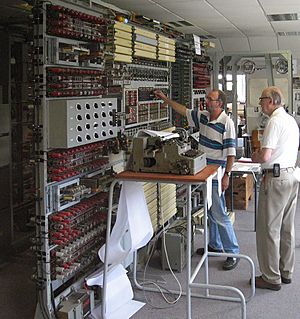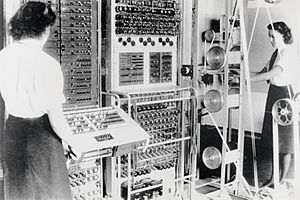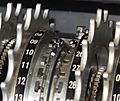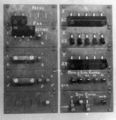Colossus computer facts for kids
Colossus was the world's first electronic digital computer that could be programmed. British code breakers used Colossus to break secret codes during World War II.
These secret messages were sent between the German High Command and their army commanders. Reading these messages helped the Allies win the war.
A codebreaker named Max Newman worked at Bletchley Park. He needed a machine to help turn German coded radio messages into normal language. A group of Post Office engineers, led by Tommy Flowers, figured out how to do this. Their design, called "Colossus," used many vacuum tubes (also called valves).
The first Colossus machine, Mark 1, started working in December 1943. It solved its first problem in February 1944. Colossus Mark 2 was even better. It started working on June 1, 1944, just before the Normandy Landings on D-Day. By the end of the war, ten Colossus computers were being used.
British codebreakers called the German radio messages "Fish." The messages were coded by a German machine they didn't know about. They called this machine and its coded messages "Tunny." Colossus copied how the "Tunny" machine worked. It read the coded message from a punched tape.
Colossus would try many different ways the "Tunny" machine's wheels might have been set up. When Colossus found likely settings for some wheels, codebreakers would then create more programs for Colossus to find the settings for other wheels. Colossus didn't do all the decoding itself. It just found the most likely settings for the machine. The results from Colossus were then given to people who knew German very well. They would finish decoding the messages.
After the war, the British codebreakers learned that the German code machine was called the Lorenz SZ42. All the secret Colossus computers were taken apart so no one would find out about them. Their designs were also destroyed. For 30 years, no one knew who had built them.
Between the early 1990s and 2007, a working copy of a Colossus computer was built. You can see this rebuilt machine at The National Museum of Computing at Bletchley Park in England.
Contents
How Colossus Helped Break Codes
Regular radio messages called "Tunny" started in June 1941. British codebreakers noticed that these messages used a five-unit code, similar to a teleprinter system. Their research also showed that the coding was done by a rotor cipher machine with 12 wheels.
For each new message, the wheels had to be turned to new starting positions. The person sending the message chose these starting positions. They would tell the person receiving the message what the starting positions were using 12 letters that were not coded. There were a huge number of possible starting positions for the 12 wheels.
The coding machine added the plaintext (the un-coded message) and a stream of characters called the keystream. This keystream was a stream of seemingly random characters that the machine made. When added together, they created the ciphertext (the coded message). The ciphertext, which looked like nonsense, was sent by radio. At the other end, an identical machine removed the keystream to get the original message back.
If the German operators always worked perfectly, no two messages would have the same starting positions for the wheels. However, mistakes were made. These mistakes helped the British codebreakers a lot. On August 30, 1941, two versions of the same message, almost 4,000 characters long, were sent with the exact same wheel starting positions. This mistake was very helpful for the codebreakers. A codebreaker named John Tiltman was able to figure out the keystream from these messages.

The codebreakers tried to figure out how the German machine worked from this information, but they struggled at first. Then, a young codebreaker named Bill Tutte joined them. He was given the job of figuring it out. After a lot of hard work, he succeeded. He created a logical description of the unseen machine. This work has been called "the greatest intellectual achievement of World War II."
Tutte figured out that the machine made each keystream character by combining the effects of two sets of five wheels. He used Greek letters to name the wheels. He called one set of five the χ ("chi") wheels, and the other set of five the ψ ("psi") wheels. He found that the χ wheels moved one position for each new character coded. The ψ wheels, however, did not move regularly. They only moved sometimes. Whether or not the ψ wheels moved was controlled by two wheels he called the μ ("mu") or "motor wheels."
Max Newman, a mathematician at Bletchley Park, was tasked with figuring out how a machine could break "Tunny" messages. This machine would do a calculation for many possible starting positions of the χ wheels. The starting position that gave the highest count from this calculation was likely the correct one. The first machine built for this was called "Heath Robinson." It didn't work very well. It used two punched paper tapes that had to move perfectly together. One tape had the coded message, and the second tape had patterns made by the coding machine's wheels. The tapes often stretched or broke when moving at 2,000 characters per second. Sometimes the tapes wouldn't line up, which made the counts wrong.
Building Colossus
Tommy Flowers worked at the Post Office Research Station in London. He was asked to look at the Heath Robinson machine. He thought it was not strong enough. He designed an electronic machine to do the same job. His machine would create the patterns of the coding machine using electronics, so only one paper tape would be needed.
In February 1943, he showed Max Newman his design. The design needed 1,500 thermionic valves (vacuum tubes). Few people believed that so many valves could work without many of them failing. More Heath Robinson machines were ordered. However, Flowers stuck with his idea for an electronic machine. He got support from Gordon Radley, who was in charge of the Post Office Research Station. Tommy Flowers and his team started building Colossus in February 1943.
The tape with the message on it had to be read very quickly. Tommy Flowers tested the tape reader up to 9,700 letters per second (about 53 miles per hour) before the tape broke. He chose 5,000 characters per second as a good speed for regular work. This meant the paper tape moved at about 40 feet per second or 27.3 miles per hour. The electronic parts were controlled by a signal made from reading the sprocket holes in the punched tape.
The first Colossus machine worked at Dollis Hill in December 1943. Then, they took Colossus apart and moved it to Bletchley Park. It arrived there on January 18, 1944. Harry Fensom and Don Horwood put it back together. Colossus read its first message on February 5. After the first Colossus (Mark 1), there were nine Mark 2 machines. These each had 2,400 valves. They were easier to use and could be programmed to work five times faster than the Mark 1. A Mark 2 Colossus first worked on June 1, 1944.
At first, Colossus was only used to find the starting positions of the wheels for a message (called wheel setting). Codebreakers then figured out how to use the Mark 2 to help find the patterns of the cams on the wheels (wheel breaking). By the end of the war, ten Colossus computers were working at Bletchley Park. This meant that many, many messages were decoded.
How Colossus Was Designed
Colossus used parts that were very new at the time. It used vacuum tubes, thyratrons, and photomultipliers. It read information from paper using light. It then performed a special task for every letter; this task could be changed. It counted how often this special task was "true." Machines with many vacuum tubes were known to break down often. They broke most when being turned on, so the Colossus machines were only turned off when a part actually broke.
Colossus was the first electronic digital machine that could be programmed. However, it couldn't be changed as easily as later computers.
- It didn't store its program inside itself. A person used plugs, wires, and switches to change the program. This is how it was set up for a new job.
- Colossus was not a general-purpose machine. It was built for only one kind of code-breaking: counting and Boolean operations (true/false logic).
It was not a "Turing-complete" computer, even though Alan Turing worked at Bletchley Park. The idea of a "Turing-complete" computer (one that can do any calculation) had not yet been fully developed. Most other early modern computing machines were also not Turing-complete. It took a long time for computers to be used for many different things, instead of just being a calculator for one hard problem.
Its Secret History
What the Colossus computers were used for was kept very secret. Colossus itself remained highly secret for many years after the war. This is why Colossus could not be included in the history of computing hardware for a long time. Nobody knew how important Tommy Flowers and the other people who helped make it were.
Not many people knew about this secret computer, so it didn't directly influence the design of later computers very much. The EDVAC computer design had the most influence on later computers.
However, once Colossus was built, some people knew that very fast electronic (no moving parts like electrical relays) digital computing devices could be made and that they wouldn't break down too often. Just knowing this was enough to have a big effect on the designs of early computers in Britain and probably in the US. People who knew about Colossus were important in the early computer field in Britain.
In 1972, Herman Goldstine wrote that:
Britain had such energy that it could right after the war start so many well-planned and well-done projects in the computer field.
When he wrote that, Goldstine didn't know about Colossus. He didn't know how much it helped the projects of people who knew about it. People like Alan Turing (with the Pilot ACE and ACE computers), and Max Newman and I. J. Good (with the Manchester Mark 1 and other early Manchester computers). Brian Randell later wrote that:
the COLOSSUS project was an important source of this energy, one that has not been well understood or known, as has the importance of its places in the time line of the invention of the digital computer.
Colossus plans and machines were secret from when they were made. They stayed secret after the war, when Winston Churchill ordered most of the Colossus machines to be destroyed into "parts no bigger than a man's hand." Tommy Flowers himself burned the designs in a fireplace at Dollis Hill. Some parts, changed to look harmless, were taken to Newman's Royal Society Computing Machine Laboratory at Manchester University. The Colossus Mark 1 was taken apart, and its parts were sent back to the Post Office.
Two Colossus computers, along with two copied Tunny machines, were kept. They were moved to GCHQ's new main office at Eastcote in April 1946. They moved again with GCHQ to Cheltenham between 1952 and 1954. One of the computers, called Colossus Blue, was taken apart in 1959; the other in 1960. In their later years, the computers were used for training. Before that, there had been attempts to change them for other purposes. Jack Good was the first to use it after the war, getting the NSA to use Colossus for something they were planning to build a special machine for. Colossus was also used to count letters on one-time pad tape to check if they were truly random.
At this time, Colossus was still secret, long after any of its technical details were important. This was because the UK's intelligence agencies used Enigma-like machines that they got other governments to buy. The agencies then broke the codes using different methods. If the knowledge of the codebreaking machines had been widely known, no one would have accepted these machines. Instead, they would have developed their own ways to encrypt messages, methods that the UK services might not have been able to break. The need for such secrets slowly went away as communications moved to digital transmission and all-digital encryption systems became common in the 1960s.
Colonel Winterbotham's book The Ultra Secret came out in 1975. This book broke the secrecy around Colossus. After that, details about the computer began to become public in the late 1970s.
A 500-page technical report on the Tunny cipher and how it was broken – called General Report on Tunny – was given by GCHQ to the national Public Record Office in October 2000. The full technical report is available online.
Making Colossus Again

A team led by Tony Sale built a working copy of a Colossus Mark 2. The original plans and machines had been destroyed, but a surprising amount of other information was not destroyed. It was mostly found in engineers' notebooks, much of it in the U.S. The optical tape reader might have been the biggest problem, but Dr. Arnold Lynch, its original designer, was able to redesign it from his own first notes. The rebuilt Colossus is on show at The National Museum of Computing, in H Block at Bletchley Park in Milton Keynes, Buckinghamshire. This is where Colossus No. 9 was used during the war.
In November 2007, to celebrate the end of the rebuilding work and to start fundraising (asking for money), they held a competition. The money would help The National Museum of Computing. It was a Cipher Competition where the rebuilt Colossus competed with radio amateurs from around the world. The first to hear and decode three messages would win. The messages were coded using the Lorenz SZ42 and sent from a radio station in the Heinz Nixdorf MuseumsForum computer museum in Germany.
The competition was easily won by radio amateur Joachim Schüth. Schüth had prepared for the event. He made his own signal processing and code-breaking program using Ada. The Colossus team lost because they wanted to use World War II radios. They were a day late because of bad radio conditions. The winner's 1.4 GHz laptop, running his own program, took less than a minute to find the settings for all 12 wheels. The German codebreaker said: "My laptop worked on coded messages at a speed of 1.2 million letters per second—240 times faster than Colossus. If you compare the two computers, you could say Colossus had a speed of 5.8 MHz. That is very fast for a computer built in 1944."
Related pages
- Jack Copeland, Colossus: Its Origins and Originators (IEEE Annals of the History of Computing, 26(4), October–December 2004, pp. 38–45).
- Jack Copeland, Colossus and the Dawning of the Computer Age, in Action This Day, 2001, ISBN: 0-593-04982-9.
- That version is a facsimile copy, but there is a transcript of much of this document in '.pdf' format at: , and a web transcript of Part 1 at:
- I. J. Good, Early Work on Computers at Bletchley (IEEE Annals of the History of Computing, Vol. 1 (No. 1), 1979, pp. 38–48)
- I. J. Good, Pioneering Work on Computers at Bletchley (in Nicholas Metropolis, J. Howlett, Gian-Carlo Rota, (editors), A History of Computing in the Twentieth Century, Academic Press, New York, 1980)
- T. H. Flowers, The Design of Colossus (Annals of the History of Computing, Vol. 5 (No. 3), 1983, pp. 239–252)
- D C Horwood, A technical description of COLOSSUS I, August 1973, PRO HW 25/24.
- Brian Randell, Colossus: Godfather of the Computer, 1977 (reprinted in The Origins of Digital Computers: Selected Papers, Springer-Verlag, New York, 1982)
- Brian Randell, The COLOSSUS (in A History of Computing in the Twentieth Century)
- Albert W. Small, The Special Fish Report (December, 1944) describe the operation of Colossus to break Tunny messages
- Harvey G. Cragon, From Fish to Colossus: How the German Lorenz Cipher was Broken at Bletchley Park (Cragon Books, Dallas, 2003; ISBN: 0-9743045-0-6) – A detailed description of the cryptanalysis of Tunny, and some details of Colossus (contains some minor errors)
- Ted Enever, Britain's Best Kept Secret: Ultra's Base at Bletchley Park (Sutton Publishing, Gloucestershire, 1999; ISBN: 0-7509-2355-5) – A guided tour of the history and geography of the Park, written by one of the founder members of the Bletchley Park Trust
- Tony Sale, The Colossus Computer 1943–1996: How It Helped to Break the German Lorenz Cipher in WWII (M.&M. Baldwin, Kidderminster, 2004; ISBN: 0-947712-36-4) – A slender (20 page) booklet, containing the same material as Tony Sale's website (see below)
- Michael Smith, Station X, 1998. ISBN: 0-330-41929-3.
- Jack Copeland: Colossus. The Secrets of Bletchley Park's Codebreaking Computers. Oxford University Press 2006. ISBN: 0-19-284055-X
- R. Rojas, U. Hashagen (eds.): The First Computers: History and Architectures. MIT Press 2000. ISBN: 0-262-18197-5. – Comparison of the first computers, with a chapter about Colossus and its reconstruction by Tony Sale.
Images for kids
-
A Lorenz SZ42 cipher machine with its covers removed at The National Museum of Computing on Bletchley Park
-
Stepping switch allegedly from an original Colossus presented by the Director of GCHQ to the Director of the NSA to mark the 40th anniversary of the UKUSA Agreement in 1986
-
Front view of the Colossus rebuild showing, from right to left (1) The "bedstead" containing the message tape in its continuous loop and with a second one loaded. (2) The J-rack containing the Selection Panel and Plug Panel. (3) The K-rack with the large "Q" switch panel and sloping patch panel. (4) The double S-rack containing the control panel and, above the image of a postage stamp, five two-line counter displays. (5) The electric typewriter in front of the five sets of four "set total" decade switches in the C-rack.
See also
 In Spanish: Colossus para niños
In Spanish: Colossus para niños









